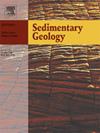Surface microtextures of quartz grains under intermittent sediment transport in a gravel bed in the Hantan River, South Korea
IF 2.9
2区 地球科学
Q1 GEOLOGY
引用次数: 0
Abstract
Surface microtextures of quartz grains (SMQs), which are observable using scanning electron microscopy (SEM), provide direct evidence for reconstructing the sedimentary history of individual grains. Detailed SMQ investigations across diverse modern river systems are essential to better understand the factors controlling SMQ formation in fluvial sediments; however, comprehensive studies of diverse modern fluvial systems remain limited. In this study, we examined SMQ characteristics in a gravel bed of the monsoon-influenced Hantan River on the Korean Peninsula. Hantan River sediments maintain angular to subangular grain outlines throughout downstream areas, exhibiting no gradual changes in either grain outlines or other mechanical microtextures. In contrast to typical fluvial sediment characteristics, upturned plates predominate rather than V-shaped percussion cracks. These features reflect episodic sediment transport driven by seasonal discharge variations in this gravel bed river system. Statistical analysis revealed distinct SMQ frequencies between the mainstream and tributaries, with the mainstream showing higher abrasion features (subangular outlines, conchoidal fractures, and V-shaped percussion cracks), whereas tributaries exhibited fresher surfaces (angular outlines and flat cleavage surfaces). These differences primarily reflect variation in transport distance from source areas, as tributaries, which are shorter and surrounded by mountainous terrain, maintained more direct sediment input characteristics, whereas mainstream sediments showed mixed features due to longer transport distance and tributary inputs. Our SMQ study in modern fluvial environments contributes to enhanced interpretations of past depositional conditions and further suggests a need to refine current SMQ classification systems.
韩国汉滩河砾石床中间歇泥沙运移下石英颗粒的表面显微结构
利用扫描电子显微镜(SEM)观察石英颗粒的表面微结构,为重建单个颗粒的沉积历史提供了直接证据。在不同的现代河流水系中进行详细的SMQ调查对于更好地了解河流沉积物中SMQ形成的控制因素至关重要;然而,对各种现代河流系统的综合研究仍然有限。在这项研究中,我们研究了朝鲜半岛受季风影响的汉滩河砾石床的SMQ特征。在整个下游地区,汉滩河沉积物保持棱角到亚棱角的颗粒轮廓,无论是颗粒轮廓还是其他机械微观结构都没有逐渐变化。与典型的河流沉积特征相反,上翻板块占主导地位,而不是v形冲击裂缝。这些特征反映了该砾石河床水系在季节流量变化驱动下的幕式输沙。统计分析显示,主流和支流之间的SMQ频率明显不同,主流表现出更高的磨损特征(亚角轮廓、贝壳状裂缝和v形冲击裂缝),而支流表现出更新鲜的表面(角轮廓和平坦的劈裂面)。这些差异主要反映了源区输沙距离的变化,由于支流较短且被山地地形包围,保持了更直接的输沙特征,而主流沉积物则因输沙距离和支流输入较长而呈现混合特征。我们在现代河流环境中的SMQ研究有助于加强对过去沉积条件的解释,并进一步表明需要完善当前的SMQ分类系统。
本文章由计算机程序翻译,如有差异,请以英文原文为准。
求助全文
约1分钟内获得全文
求助全文
来源期刊

Sedimentary Geology
地学-地质学
CiteScore
5.10
自引率
7.10%
发文量
133
审稿时长
32 days
期刊介绍:
Sedimentary Geology is a journal that rapidly publishes high quality, original research and review papers that cover all aspects of sediments and sedimentary rocks at all spatial and temporal scales. Submitted papers must make a significant contribution to the field of study and must place the research in a broad context, so that it is of interest to the diverse, international readership of the journal. Papers that are largely descriptive in nature, of limited scope or local geographical significance, or based on limited data will not be considered for publication.
 求助内容:
求助内容: 应助结果提醒方式:
应助结果提醒方式:


